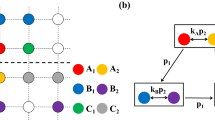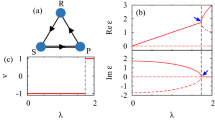Abstract
Biodiversity is essential to the viability of ecological systems. Species diversity in ecosystems is promoted by cyclic, non-hierarchical interactions among competing populations. Central features of such non-transitive relations are represented by the ‘rock–paper–scissors’ game, in which rock crushes scissors, scissors cut paper, and paper wraps rock. In combination with spatial dispersal of static populations, this type of competition results in the stable coexistence of all species and the long-term maintenance of biodiversity1,2,3,4,5. However, population mobility is a central feature of real ecosystems: animals migrate, bacteria run and tumble. Here, we observe a critical influence of mobility on species diversity. When mobility exceeds a certain value, biodiversity is jeopardized and lost. In contrast, below this critical threshold all subpopulations coexist and an entanglement of travelling spiral waves forms in the course of time. We establish that this phenomenon is robust; it does not depend on the details of cyclic competition or spatial environment. These findings have important implications for maintenance and temporal development of ecological systems and are relevant for the formation and propagation of patterns in microbial populations or excitable media.
This is a preview of subscription content, access via your institution
Access options
Subscribe to this journal
Receive 51 print issues and online access
$199.00 per year
only $3.90 per issue
Buy this article
- Purchase on Springer Link
- Instant access to full article PDF
Prices may be subject to local taxes which are calculated during checkout




Similar content being viewed by others
References
Durrett, R. & Levin, S. Allelopathy in spatially distributed populations. J. Theor. Biol. 185, 165–171 (1997)
Durrett, R. & Levin, S. Spatial aspects of interspecific competition. Theor. Pop. Biol. 53, 30–43 (1998)
Kerr, B., Riley, M. A., Feldman, M. W. & Bohannan, B. J. M. Local dispersal promotes biodiversity in a real-life game of rock-paper-scissors. Nature 418, 171–174 (2002)
Czárán, T. L., Hoekstra, R. F. & Pagie, L. Chemical warfare between microbes promotes biodiversity. Proc. Natl Acad. Sci. USA 99, 786–790 (2002)
Szabó, G. & Fáth, G. Evolutionary games on graphs. Phys. Rep. 446, 97–216 (2007)
Dykhuizen, D. E. Santa rosalia revisited: Why are there so many species of bacteria? Antonie Van Leeuwenhoek 73, 25–33 (1998)
Smith, J. M. Evolution and the Theory of Games (Cambridge Univ. Press, Cambridge, 1982)
Hofbauer, J. & Sigmund, K. Evolutionary Games and Population Dynamics (Cambridge Univ. Press, Cambdrige, 1998)
Nowak, M. A. Evolutionary Dynamics (Belknap Press, Cambridge, Massachusetts, 2006)
May, R. M. & Leonard, W. J. Nonlinear aspects of competition between species. SIAM J. Appl. Math. 29, 243–253 (1975)
Johnson, C. R. & Seinen, I. Selection for restraint in competitive ability in spatial competition systems. Proc. R. Soc. Lond. B 269, 655–663 (2002)
Reichenbach, T., Mobilia, M. & Frey, E. Coexistence versus extinction in the stochastic cyclic Lotka-Volterra model. Phys. Rev. E 74, 051907 (2006)
Jackson, J. B. C. & Buss, L. Allelopathy and spatial competition among coral reef invertebrates. Proc. Natl Acad. Sci. USA 72, 5160–5163 (1975)
Sinervo, B. & Lively, C. M. The rock–scissors–paper game and the evolution of alternative male strategies. Nature 380, 240–243 (1996)
Kirkup, B. C. & Riley, M. A. Antibiotic-mediated antagonism leads to a bacterial game of rock–paper–scissors in vivo. Nature 428, 412–414 (2004)
Levin, S. A. Dispersion and population interactions. Am. Nat. 108, 207–228 (1974)
Hassell, P. M., Comins, H. N. & May, R. M. Spatial structure and chaos in insect population dynamics. Nature 353, 255–258 (1991)
Blasius, B., Huppert, A. & Stone, L. Complex dynamics and phase synchronization in spatially extended ecological systems. Nature 399, 354–359 (1999)
King, A. A. & Hastings, A. Spatial mechanism for coexistence of species sharing a common natural enemy. Theor. Pop. Biol. 64, 431–438 (2003)
Durrett, R. & Levin, S. The importance of being discrete (and spatial). Theor. Pop. Biol. 46, 363–394 (1994)
Redner, S. A Guide to First-Passage Processes (Cambridge Univ. Press, Cambridge, 2001)
Hastings, A. Transients: the key to long-term ecological understanding? Trends Ecol. Evol. 19, 39–45 (2004)
Berg, H. C. E. coli in Motion (Springer, New York, 2003)
Igoshin, O. A., Welch, R., Kaiser, D. & Oster, G. Waves and aggregation patterns in myxobacteria. Proc. Natl Acad. Sci. USA 101, 4256–4261 (2004)
Siegert, F. & Weijer, C. J. Spiral and concentric waves organize multicellular Dictyostelium mounds. Curr. Biol. 5, 937–943 (1995)
Thul, R. & Falcke, M. Stability of membrane bound reactions. Phys. Rev. Lett. 93, 188103 (2004)
Gardiner, C. W. Handbook of Stochastic Methods (Springer, Berlin, 1983)
Wiggins, S. Introduction to Applied Nonlinear Dynamical Systems and Chaos Ch. 2 and 3 (Springer, New York, 1990)
Aranson, I. S. & Kramer, L. The world of the complex Ginzburg-Landau equation. Rev. Mod. Phys. 74, 99–143 (2002)
Hauert, C., de Monte, S., Hofbauer, J. & Sigmund, K. Volunteering as red queen mechanism for cooperation in public goods games. Science 296, 1129–1132 (2002)
Gillespie, D. T. A general method for numerically simulating the stochastic time evolution of coupled chemical reactions. J. Comput. Phys. 22, 403–434 (1976)
Acknowledgements
We thank M. Bathe and M. Leisner for discussions on the manuscript. Financial support of the German Excellence Initiative via the program “Nanosystems Initiative Munich (NIM)” as well as the SFB “Manipulation of Matter at the Nanometer Length Scale” is gratefully acknowledged. M.M. is grateful to the Alexander von Humboldt Foundation for support through a fellowship.
Author information
Authors and Affiliations
Corresponding author
Ethics declarations
Competing interests
Reprints and permissions information is available at www.nature.com/reprints. The authors declare no competing financial interests.
Supplementary information
Supplementary Notes
This file contains Supplementary Notes on the concept of extensivity, on stochastic partial differential equations and the complex Ginzburg-Landau equation as well as on scaling arguments. Details on the Supplementary Videos 1 and 2 are given. This file was corrected on 4 September 2007. (PDF 125 kb)
Supplementary Video 1
This file contains Supplementary Video 1. The video shows the temporal development of the three species when mobility is small and coexistence is stable. (MOV 9805 kb)
Supplementary Video 2
This file contains Supplementary Video 2. The video shows the temporal development of the three species when mobility is near the critical value, coexistence is still stable. (MOV 9794 kb)
Rights and permissions
About this article
Cite this article
Reichenbach, T., Mobilia, M. & Frey, E. Mobility promotes and jeopardizes biodiversity in rock–paper–scissors games. Nature 448, 1046–1049 (2007). https://doi.org/10.1038/nature06095
Received:
Accepted:
Issue Date:
DOI: https://doi.org/10.1038/nature06095
This article is cited by
-
Response of a three-species cyclic ecosystem to a short-lived elevation of death rate
Scientific Reports (2023)
-
Community composition and the environment modulate the population dynamics of type VI secretion in human gut bacteria
Nature Ecology & Evolution (2023)
-
VisualPDE: Rapid Interactive Simulations of Partial Differential Equations
Bulletin of Mathematical Biology (2023)
-
Modulation of microbial community dynamics by spatial partitioning
Nature Chemical Biology (2022)
-
The effect of territorial awareness in a three-species cyclic predator–prey model
Scientific Reports (2022)
Comments
By submitting a comment you agree to abide by our Terms and Community Guidelines. If you find something abusive or that does not comply with our terms or guidelines please flag it as inappropriate.



